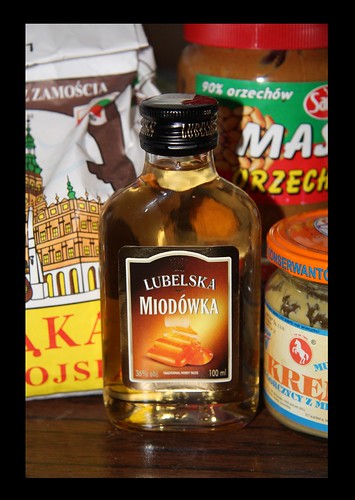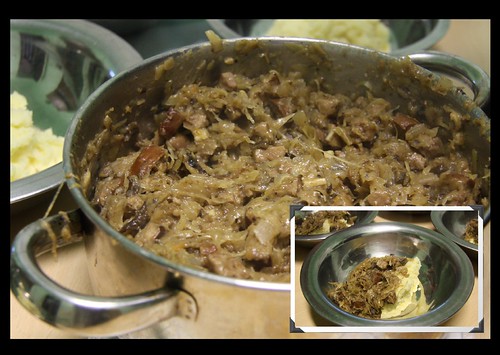Best. Ever. Bigos. (OR “I never cooked with vodka before”) * and also an addendum about pickles just for the fun of it *
Krakow, Poland

Prepare at least three days before needed!
Preferably make a huge portion and leave it sitting on your balcony all winter long.
1kg fresh white cabbage, shredded finely
1t salt
Place in a heavy pot with water to cover and bring to the boil
Cook uncovered over a medium heat for about 30 minutes or until tender
1kg sauercraut, rinsed and well drained
1/2kg pre-cooked or smoked pork and/or ham, chopped into bite-size pieces
1/2kg kielbasa, chopped into bite-size pieces
1 large onion, chopped finely
1T minced garlic
50g dried mushrooms
8 prunes, pitted and cut into small pieces
1T peppercorns
1-2 bay leaves
1/2-1T allspice
Add to the fresh cabbage and stir well
250g bacon, chopped
Saute until crisp, drain off excess fat and add to the above
Cook uncovered for 20 minutes on a medium heat, then cover and simmer over a
low heat for at least one hour
Remove and discard bay leaves
Set aside in a cool place
The following day…..
50ml vodka or 1/2C dark red wine
Add, taste and add seasoning as needed
Then cover and cook over a low heat for at least an hour
Repeat the following day, and also before serving. (it really is worth the daily cooking – every day it gets darker and darker, and tastes stronger and stronger).
Serve with boiled potatoes or dark rye bread.
Any leftovers can be reheated. Although, when we make it again we’ll need to at least double the recipe, because we gobbled it all up in one sitting. (Actually, our family version is likely to have a greatly increased amount of cabbage with no change being made to the meat quantity. Additionally, we’ll use red wine rather than vodka, because it adds a great deal to the appearance, which, as you can see, could not be classed as one of its finer features as is.)

* cubed venison steak and/or a ham hock can also be used (it was, after all,
traditionally a hunter’s stew)
* in times past every home in Eastern Europe had a barrel of pickled cabbage, which
was prepared in the autumn and used through the winter – we have been
fortunate enough to be able to buy this home-prepared brew at the market.
And while we’re writing about pickled veges, here’s The World’s Best Pickling Recipe according to Janette Blackwell, who I don’t know from a bar of soap, but to whom I was introduced by Mr Google. Of all the pickle recipes I read, I enjoyed hers the most, and even though it’s Bulgarian and not Polish, I’m sure Polski pickles wouldn’t be too dissimilar. I wonder if hers explode!
The World’s Best Pickles – Author: Janette Blackwell
I knew they were the world’s best pickles the moment I tasted one. That first taste took place around 1950, and I’ve tasted a lot of pickles since, am a pickle hound in fact, but I’ve never come across anything else as good.
They came to us by way of my Uncle Ronald Smith, who was an electrician in the Bitterroot Valley of Montana where I grew up. One day he was doing electrical work for a Bulgarian family, and they rewarded him with a sample pickle. He liked it so much he got the recipe and gave it to his wife Gladys, who gave it to Grandma Glidewell, who made it and gave some to me, and I thought I’d died and gone to pickle heaven.
And thus, although they became an old Glidewell family recipe, they are really an old Bulgarian family recipe. The Bulgarian family, whose name I do not know, told Uncle Ronald that in Bulgaria, when the first heavy frost kills the tomato vines, they put all their end-of-garden vegetables — including those green tomatoes — into a barrel, fill the barrel with pickling brine, and eat the best pickles in the world all winter. It turns out, though, that the pickles’ travel from Bulgaria to the U.S. was only one leg of a more ancient journey. Because I mentioned them to an Iranian woman, and she said, “My family has always made pickles like that! Exactly like that, except we add tarragon.”
Iran being the new name for the ancient kingdom of Persia, who knows how many centuries these pickles go back?
There’s more: I later lost the recipe’s brine proportions. Gave some thought to its travels between Persia and Bulgaria, looked in an Armenian-American cookbook (Treasured Armenian Recipes, published in 1949 by the Armenian General Benevolent Union) and there they were, under “Mixed Pickles No. 2.” Turns out the world’s best Armenian pickles are just like the world’s best Bulgarian and Persian and American pickles, except they include dill, and sometimes green beans and coriander seed.
So this is an old, old recipe belonging to the whole human family.END-OF-GARDEN PICKLES RECIPE
Vegetables:
Green tomatoes, cut in half or quartered if large
The green tomatoes for this recipe should be at least thinking of getting ripe.
A tomato demonstrates its thoughts along this line by getting a white overlay
on top of the green.
Carrots, peeled and cut into strips
Cauliflower, separated into small florets
Baby onions, peeled, or larger onions halved
Quartered green peppers, cut into broad lengthwise slices
Garlic, two peeled cloves per quart jar
Medium-hot peppers, two small whole peppers per quart
You can also add unpeeled and unwaxed small cucumbers, zucchini, or lightly cooked green beans, though we never did. The hot peppers add adventure and zest, but if you prefer to save your tears for really sad occasions, why not?
Amounts and proportions depend on what vegetables you have and how many quarts you plan to make. You don’t have to have the green tomatoes, and the other things can be bought in a grocery store. But you do need a variety of vegetables, and you have to have the onions and garlic, or you won’t have the world’s best pickles. You will have the world’s so-so pickles, and that would be a shame.Armenian-Persian-Bulgarian Brine
To one quart of water add 1/4 cup pickling salt (salt that isn’t iodized), and one cup of white distilled vinegar. Bring the mixture to a boil. This is enough brine to cover two quarts of mixed pickles, with a little left over.Processing
Follow the canning instructions in a good, standard cookbook. Or, if you plan to eat them right away, pack the vegetables into clean quart jars, pour over them the hot brine, and keep the pickles covered in the refrigerator. Some of the more impressionable vegetables, like zucchini, will be ready to eat in only two or three days.
Tags: 2008/09, food, postcard: Poland, tradition




That recipe, Rach – what on earth do you cook it in? Is a large stock pot big enough? And you are right – it doesn’t look pretty 🙂 Almost intrigued enough to try it though …
Good to start off in a big pot, but it will cook down to a not-so-enormous pot-full.
We now have the world’s most amazing stock pot and will be able to make a 5x batch of the stuff at once! It’s big enough for us to make soup for three nights for all of us. See why we’re carrying it round the world? The best souvenir!!!
” who I don’t know from a bar of soap” That made me smile and think
of my Aunt Niner , age 85 and my Mama, who used the expression often…..” I don’t know them ( or him or her) from Adam’s house cat”
I really enjoy reading your postings.
MarthaAnn
Quincy, Florida
USA